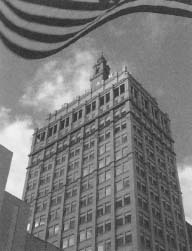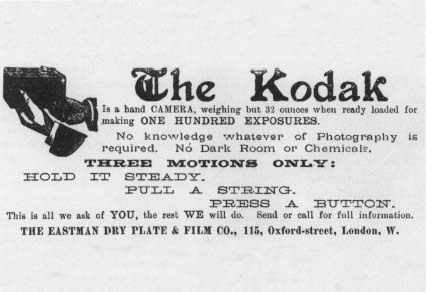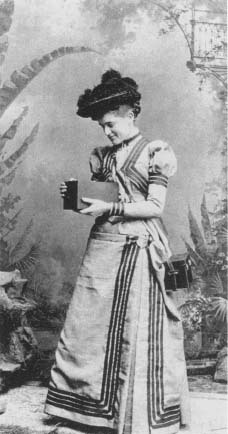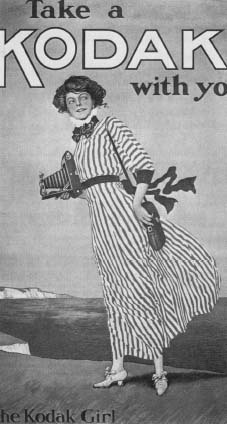Eastman Kodak
Company
343 State Street
Rochester, NY 14650
(716) 724-4000
www.kodak.com

For more than 120 years, Eastman Kodak has helped people around the world capture their most memorable occasions on film. The company began in the late 1800s, when Kodak founder George Eastman almost single-handedly took photography from a science practiced by a few professionals and dedicated amateurs to a hobby anyone could enjoy. Kodak sold easy-to-use cameras and film, then developed its customers' pictures.
Photography, however, would not be Eastman Kodak's only business. It provided film and equipment to Hollywood moviemakers and hospitals. Eventually, however, the company's products touched on anything that could record an image—from copying machines to videotape. Now, in the twenty-first century, Kodak plays a major role in digital imaging, using the power of computers to capture, store, and display pictures and other information.
From Dry Plates to Roll Film
When George Eastman of Rochester, New York, bought his first camera in 1877, taking and developing a picture was time-consuming, awkward, and messy. Photographers used a "wet-plate" process featuring heavy glass plates covered with a mixture of silver and other chemicals. After a picture was taken, it took an entire day for it to develop. This method was gradually replaced by a system that used a glass plate treated first with gelatin. The "dry-plate" process, first developed in Great Britain, required fewer chemicals to produce a picture.
Eastman perfected his own dry-plate method, including a machine that put the chemicals on the plates. He received a patent on the process in April 1880 and set up a small factory—a one-room operation above a Rochester music store. Before the end of the year, he had a local investor, Henry Strong, interested in his business. On January 1, 1881, Eastman and Strong became partners in the Eastman Dry Plate Company.
Film was soon added to the company's product line, as Eastman perfected a way of putting the gelatin-and-chemical mixture on rolls of paper. The paper rolls reduced the weight of cameras and the time it took to take pictures. Eastman also designed a special roll-holder so the film could be used in existing plate cameras. Eastman won international praise for the new system, and he set up a London branch of the company to handle worldwide sales. Eastman also began making cameras. The company's first camera was created in 1887, but only a few were made. The next camera, however, changed photography forever.
Eastman Kodak at a Glance
- Employees: 78,400
- CEO: Daniel A. Carp
- Subsidiaries: BASO Precision Optics, Ltd.; Cinesite, Inc.; E. K. Holdings B.V.; PictureVision, Inc.; Qualex, Inc.,
- Major Competitors: Canon U.S.A., Inc.; Fuji Photo Film Company; Nikon Inc.; Polaroid Corporation; Panavision, Inc.; CPI Corporation
- Notable Products: Digital Science digital cameras; EasyShare digital cameras; Advantix cameras; Max one-time use cameras; Elite film; Gold film; Kodachrome film; Ektachrome film; Photo CD; ImageSource copier
Kodak Does the Rest
Built in a small wooden box, the new Eastman camera cost $25. It contained the patented Eastman roll-holder and was sold with a roll of film that took one hundred pictures. After finishing the roll, the photographer sent the entire camera back to Eastman. The company developed the negatives and returned the camera with a fresh roll of film. Eastman called his new camera the Kodak.
The Kodak camera was an instant success. For the first time, anyone could easily take their own pictures. Eastman sold five thousand Kodaks in just six months and began developing new models. A smart businessman as well as an inventor, Eastman immediately put money into promoting his new product. Eastman wrote what became one of the first great advertising slogans: "You push the button, we do the rest."
Timeline
- 1881:
- George Eastman and partner Henry Strong form the Eastman Dry Plate Company.
- 1888:
- The first successful Kodak camera appears on the market.
- 1892:
- Eastman renames his business the Eastman Kodak Company.
- 1900:
- The Brownie camera, priced at $1, makes photography affordable.
- 1912:
- Eastman Kodak opens its research laboratory.
- 1923:
- Kodak introduces home movie-making equipment.
- 1950:
- An improved film for motion pictures earns Eastman Kodak an Academy Award.
- 1962:
- The Instamatic, Kodak's most popular camera ever, appears in stores.
- 1984:
- Kodak begins selling videotape and computer floppy discs.
- 2002:
- Company creates Appairent Technologies to focus on digital technology.
In 1889, a Kodak chemist created a new roll of film made out of celluloid, the first plastic. The new film was transparent and flexible. Sales of the new film took off; all along, Eastman knew that making film and developing would be his true moneymaker. People loved the idea of taking their own pictures, especially on vacations and at family gatherings. The Kodak name was soon known around the world, and it was featured in songs and books. Eastman eventually changed the name of his business to the Eastman Kodak Company.
Controlling the Market
Almost from the beginning, Eastman wanted to dominate the new market he created. He bought photographic patents held by others and introduced innovative new products. Kodak sold a pocket camera in 1895 and the inexpensive Brownie camera appeared five years later. Eastman Kodak opened its first overseas plant in London in 1891, and by 1900 it had distribution sites in other European countries. Going into the twentieth century, Kodak controlled about 90 percent of the photography market.
The Eastman Kodak empire went beyond snapshots and simple cameras. Eastman provided cameras and film to the new motion picture industry, first located in the East and then transplanted to California. Kodak also provided film for X-ray machines, which first appeared in 1896. The company's other innovations included a machine that did not require a dark room to develop negatives, "safety film," which was less flammable than the original celluloid film, and a new film for professional photographers.
By 1907, Kodak had more than five thousand employees worldwide, and in 1912, the company opened its own research-and-development (R&D) lab, making it one of the first companies in the world with this kind of facility. One of its greatest developments was Kodachrome, Kodak's name for color film, which was used for the first time during the 1930s.
George Eastman gave several explanations about the origins of the name "Kodak." According to Eastman biographer Elizabeth Brayer, the inventor liked the letter K because it was "strong and incisive … firm and unyielding." It was also the first letter of his mother's maiden name. Eastman thought Kodak was easy to say and easy to remember—important qualities for a new product.
Success, however, brought legal problems. A New Jersey minister, Hannibal Goodwin, had filed a patent for celluloid roll film just before Eastman did. A long legal battle over who had claim to the patent ended in 1914, when Kodak paid a $5 million settlement. The next year, a federal judge ruled that Eastman Kodak was an illegal monopoly, which means it controlled too much of the photography industry. The company challenged the decision, but in 1921, Kodak agreed to sell several plants that produced paper and dry-plate technology—not its most important products. Eastman Kodak continued to be the major power in the photography industry, expanding

Kodak after Eastman
In 1932, George Eastman tragically committed suicide, leaving behind a legacy that would endure for generations. His company expanded to become Rochester's major industry; the complex known as Kodak Park eventually covered several thousand acres; and Eastman had become a leader known for treating his workers fairly. He offered a form of profit-sharing as early as 1899, and added other benefits over the years. In profit-sharing, each worker is given a bonus based on how well the company's sales are going. Eastman's style continued under his successors.
After providing film and cameras to the U.S. government during World War II (1939-45), Kodak returned to amateur and professional photography and filmmaking. New products included a cheaper home-movie camera, improved motion picture film, and better equipment for developing film. In 1953, Kodak formed Eastman Chemical Products to market industrial materials, including plastics and fibers.

By 1962, Kodak's annual sales in the United States alone were $1 billion. The company had just introduced the Carousel, a popular automatic slide projector, and in 1962 it began selling the Instamatic camera. Its film came in a small cartridge that was easy to handle. The Instamatic introduced a new age of simple amateur photography, just as the first Kodak had seventy-five years before. By 1970, the company sold fifty million Instamatics. During that decade, Eastman Kodak also entered into the copier business with its Ektaprint machine. The copier, however, did not gain much ground in the market, facing tough competition from industry leaders Xerox and IBM.
A Cloudier Picture
The Ektaprint experience reflected a growing problem within Kodak. As new technologies emerged, the company was often slow to adapt them, or to take risks with new products it developed. Kodak built a video recorder and camera system before such equipment was common, but it feared customers would not accept the high cost. In 1984, Forbes quoted an unnamed industry analyst looking back at that time: "They were so used to selling $20 cameras, they couldn't believe there was a mass market for $500 machines." In the late 1970s, when VCRs became popular, Kodak did not have a product to sell.
Kodak repeated its copier experience with instant cameras. It waited until 1976 to compete with Polaroid, the pioneer of instant photography. The Kodak camera did not sell well, and the company was sued for violating some of Polaroid's patents. Kodak lost its court battle in 1986, stopped selling instant cameras, and paid Polaroid almost $1 billion in damages.

The Polaroid settlement was part of a string of setbacks during the 1970s and 1980s. In the film market, Kodak lost ground to Fuji, a Japanese company. In cameras, cheaper 35 millimeter cameras competed against Kodak products. And when the company finally entered the video recorder business, it backed a format that was not compatible with the popular VHS system. Although sales were strong—topping $10 billion in 1983—profits went down.
During this period, Kodak introduced its Disc camera, which took pictures on a small disc instead of a roll of film. Despite heavy advertising, the camera flopped. The company also entered new businesses, buying Atex, a computer publishing venture; Verbatim, a company that made floppy discs for computers; and Sterling, a drug manufacturer. Most of these new businesses were not successful, but the Atex and Verbatim deals showed that Kodak was preparing to expand even more into electronics and computers.
Entering the Digital Age
One of Kodak's first digital imaging products was the Photo CD. Released in 1991, the CD stored hundreds of photos taken on roll film. The company later introduced new digital cameras, but it faced tough competition from such Japanese companies as Sony and Canon. Through the 1990s, Kodak saw sales fall from $20 billion in 1992 to under $14 billion in 2000. During this time, the company went through several changes at the top. In 1993, George M. C. Fisher replaced Kay Whitmore as chief executive officer (CEO). At the beginning of 2000, Fisher was replaced by Daniel Carp. In a company statement issued when he took over, Carp said, "The picture business today is on the verge of the greatest breakthroughs since George Eastman put photography in the hands of consumers. We are changing the ways our customers and consumers can bring new uses and meaning to pictures—no matter what the technology.
Fighting Pollution
From its founding, Eastman Kodak has been a chemical company, since photography depends on special light-sensitive chemicals to produce pictures. By the 1980s, Kodak Park in Rochester, New York, included about two hundred manufacturing buildings, many of which produced chemical waste. In 1988, New York officials learned that some chemicals had entered groundwater near Kodak Park, posing a possible health hazard to local residents. In 1990, Kodak admitted it had violated state environmental laws and paid $2 million in fines.
Kodak's environmental problems, however, were not over. Although the company pledged to cut its chemical emissions, it remained New York's largest polluter through most of the 1990s. Housing values fell because of the pollution, and Kodak offered to help pay relocation costs for people who wanted to move. In October 1994, Kodak was fined $5 million by the U.S. government for breaking federal pollution laws. That fine was reduced from $8 million, because Kodak promised to fix environmental problems. By 2000, Kodak reported it had reduced emissions at Kodak Park by almost 80 percent from 1987 levels.
The changing lineup of Kodak executives faced similar issues: keeping profits up in a traditional business while moving farther into digital imaging. In 2001, Marty Coyne, head of Kodak's commercial business group, told Ziff Davis reporter Michael Ryan, "It's going to cost money to get the digital pieces in place. We have to invest in our future." By then, Kodak had several successful digital products on the market, including the best-selling digital camera and a device that takes digital pictures and plays music recorded in the MP3 format. In 2002, the company created a new firm, Appairent Technologies, out of its R & D lab. Appairent focuses on the wireless transmission of digital information.